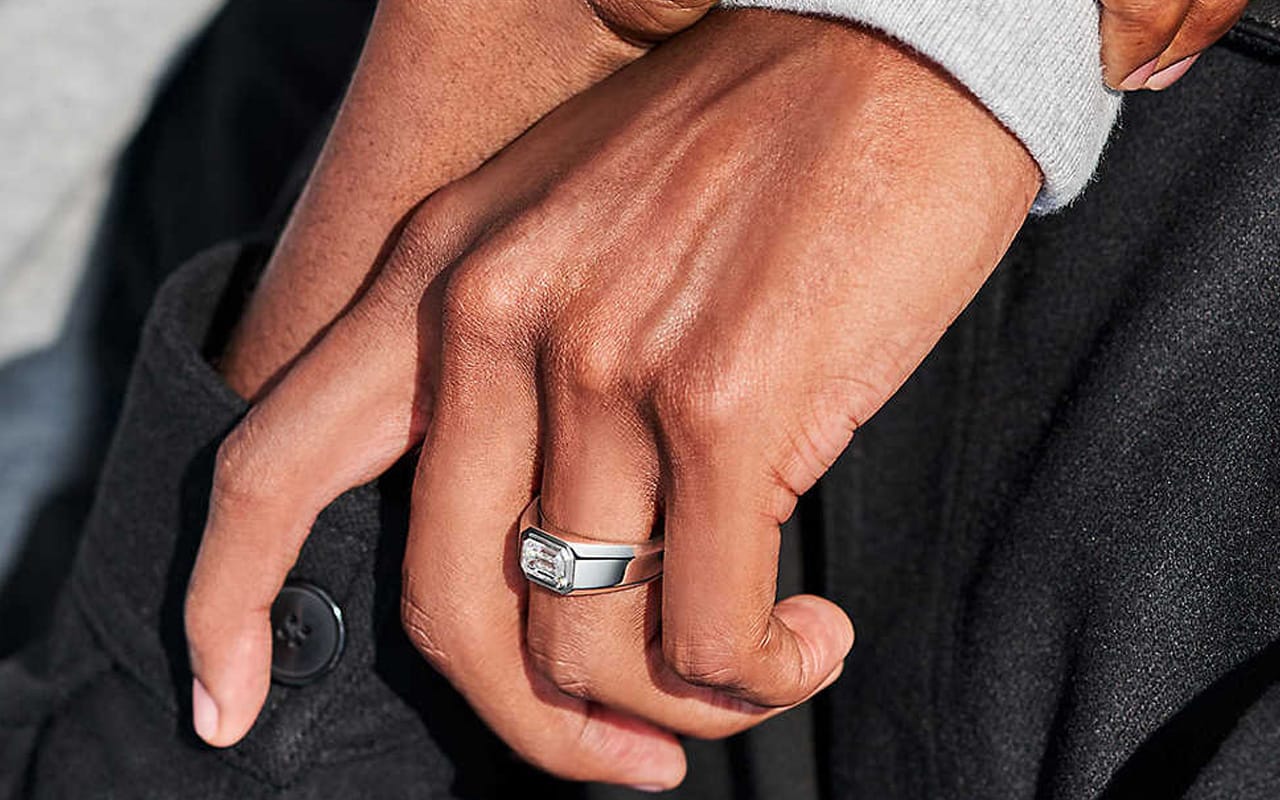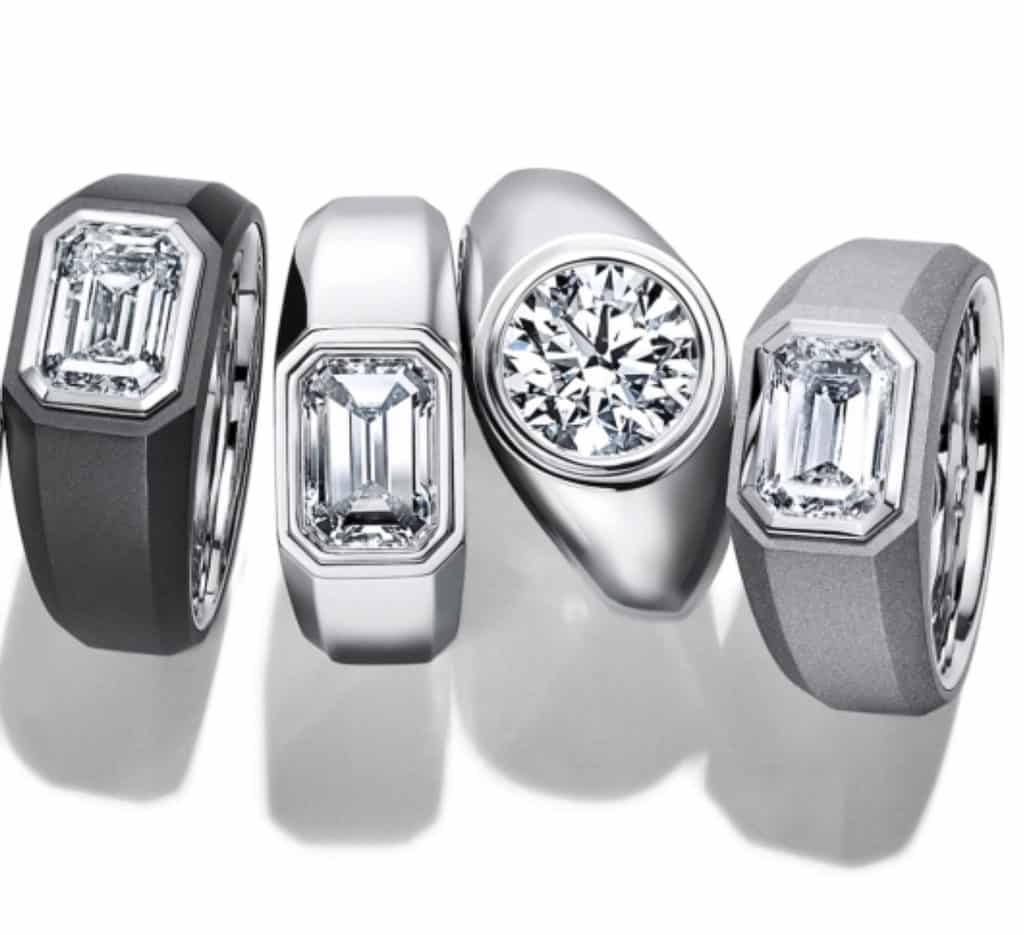Blog
Home » Diamonds blog » AS GENDER LINES BLUR IN FASHION AND CULTURAL WORLDS, TIFFANY RELEASES MEN’S DIAMOND ENGAGEMENT RING COLLECTION
Focus on

“Following in the footsteps of its iconic sister, The Charles Tiffany Setting honors the jeweler’s long-standing legacy in love and inclusivity, paving the way for new traditions to celebrate our unique love stories and honor our most cherished commitments to one another,” the company stated in its public announcement.
Tiffany’s first diamond engagement ring designs for men are a modern and represent a departure from the traditional wedding band. Recalling a signet silhouette, the platinum and titanium designs revise a classic men’s style with powerful contours, a contemporary profile and feature a striking center diamond.
The first Charles Tiffany Setting jewelry will be available in round brilliant and emerald-cut diamonds of up to 5 carats. The styles with a round brilliant diamond showcase a streamlined knife-edge band, while the styles with an emerald-cut diamond feature strong, architectural beveled edges.
GROWING VIABILITY OF MEN’S JEWELRY MARKET
The male diamond market has always proven to be an elusive holy grail for the jewelry industry – massively promising, given the fact that is made up of close to half the human being living on the face of the earth, but still an underperformer.
According to Euromonitor, the men’s jewelry market in general shrank by more than 20 percent in 2020 to $4.6 billion, largely as a result of the COVID crisis. Sales of men’s luxury fine jewelry had approached $5.8 billion in 2019, up from $4.3 billion in 2012. Still, it represents a little more than 15 percent of the market for women’s jewelry.
Rings are the most popular men’s jewelry item around the world, with NPD Group noting in a 2018 New York Times report that they generate one-third of the men’s jewelry sales and almost two-thirds of the industry growth in the United States.

Tiffany’s first diamond engagement ring designs for men are a modern and represent a departure from the traditional wedding band.
Necklaces and chains are the second largest men’s jewelry category, accounting for about one-quarter of sales.”
It should be noted, however, that the typical skepticism about the viability of a male market for jewelry is a somewhat misplaced, if one considers that upward of 70 percent of the market for watches is male, and, although they are more functional than most jewelry, in age where a wristwatch is not really required to know the time, the watch itself essentially can be likened to jewelry.
What is more, with the rapidly growing market share of digital watches, which are not only a fraction of the price but considerably more functional than the standard Rolex or Breitling timepiece, there would appear to be a real opportunity for dedicated male jewelry lines to appeal to more men wanting to make a fashion or personal statement.
FORGOING PERCEPTIONS OF MASCULINITY
How are men being convinced to forgo popular conceptions of what defines masculinity, and put on a piece of jewelry featuring a diamond?
“Many men are not used to wearing jewelry,” said Sue Millar Perry, content director at David Perry & Associates, a company that produces custom magazines for top luxury jewelry and watch retailers, speaking to the New York Times. “So, you’re seeing more rings marketed for their ‘comfort fit,’ which means in essence that the ring is crafted so the inside of the band is slightly domed — instead of flat against the skin — to create a fit which is comfy on the finger and easier to squeeze over a knuckle.”
What is being discussed at present is more refined, mainstream diamond jewelry, which a wide range of men would wear without necessarily defining themselves culturally. It would differ from the bling jewelry that was popularized by African American rappers and athletes in the 1980s and 1990s. Wildly popular at the time, it was considered both a fashion statement and a declaration of cultural identity.
According to Paola De Luca, the founder and creative director for The Futurist, the publisher of TrendVision, the lines separating gender roles are blurring in the jewelry sector. “Images of a hyper-masculine man in business clothing not wearing any jewelry are fading away,” she said. “Men have become more image-conscious, especially Millennials.”

The first Charles Tiffany Setting jewelry will be available in round brilliant and emerald-cut diamonds of up to 5 carats.
.
